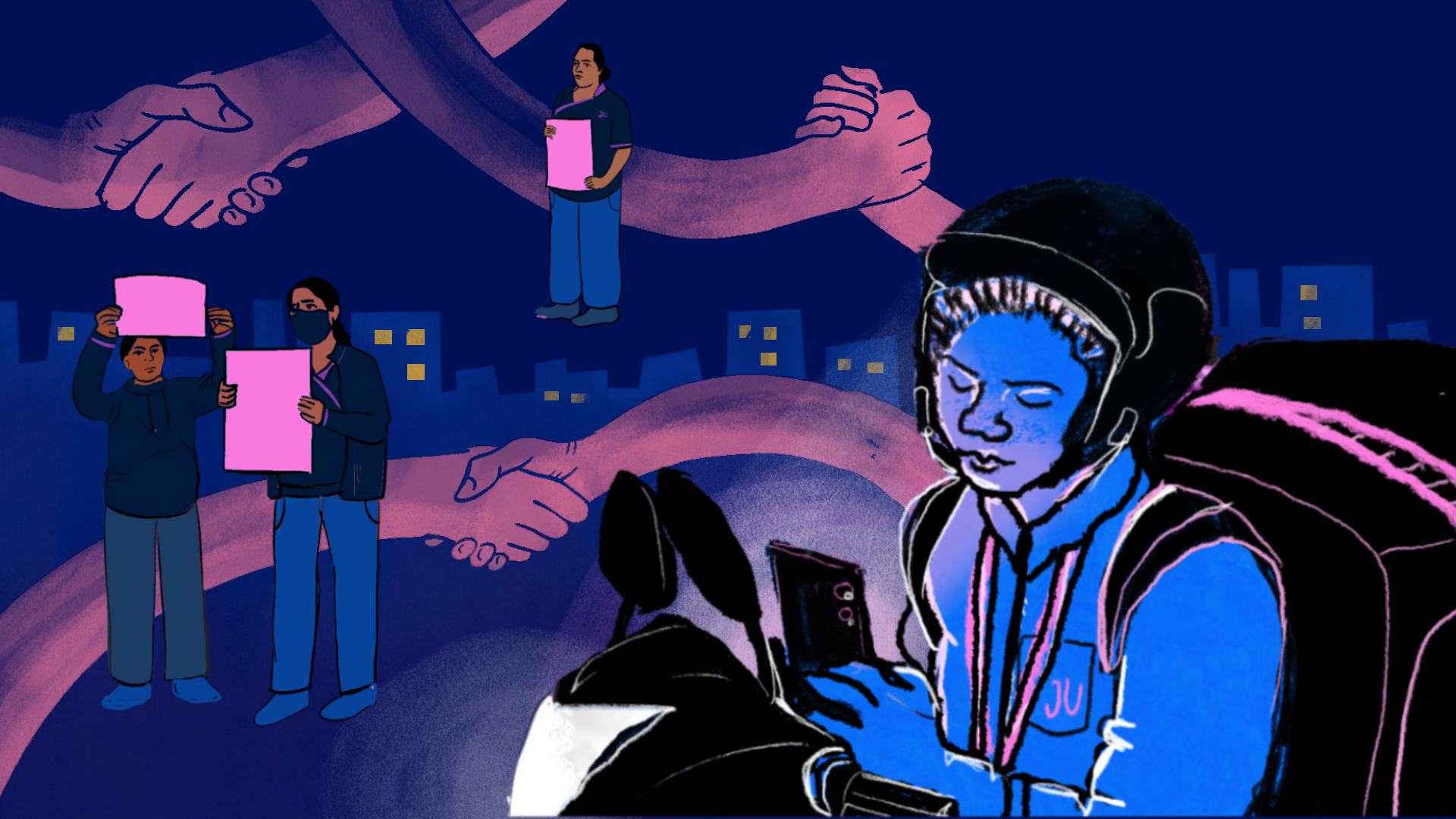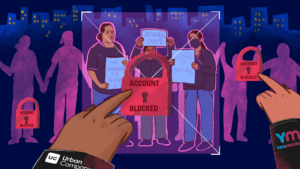Platform Work Unions Are Fighting Gender And Caste Bias, Clearing New Paths To Resistance
Gig workers are blending digital tools, community ties and the old spirit of unions to reimagine labour movements without gender and caste biases

If you ask Manju about the first solidarity network she was a part of, she responds with a gentle grin. There have been many in the last 15 years, she says, where does she begin? Before platforms entered India, and before joining the Gig and Platform Service Workers’ Union (GIPSWU), she worked with bonded labourers, street vendors, homeless people, women and children, across Uttar Pradesh, Madhya Pradesh and Bihar.
There were tensions in the early days. “Mere parivaar wale mujhse alag hogaye mere kaam ko le kaar (my family disowned me over this),” she says. They were especially upset over photographs of her with her male colleagues. It took her years to channel her anger, learn how to organise, and build relationships. Now, she says, all workers are her family. This year, she represented GIPSWU at the ILO convention, speaking about women’s lives on platform work. “Pehele India mein, ab bahar. Kabhi socha nahi tha (I never thought I would be on a national and then global stage).”
Platform workers operate in fragmented, opaque supply chains, under the gaze of algorithms, without social or economic protections and workers’ unions are fighting to secure democratic and legally binding rights for them, as we reported in the first part of this series. In the concluding part, we talk about the older social hierarchies that these unions have to battle – caste and sexism.
These movements, like their predecessors, tend to be male-dominated, shaped around men’s work, their time, their priorities. Unpaid care work, family norms, and now gendered gigs in digitally scattered platforms keep women from fully and freely participating. The ILO acknowledges this as does other research.
“We have to rebuild the whole movement – find a way to reimagine how we organise and build narratives to challenge digital patriarchy and digital capitalism,” says Chandan Kumar, who organises with GIPSWU.
As we reported, the design of the platform economy is not conducive to traditional unionising. In the case of women, there is constant negotiation for time, space and personal freedom. On calls, Nisha, an organiser with GIPSWU, says she has heard husbands or her in-laws discouraging women audibly: “Chup chaap kaam karne ka, lafdon mein nahin padhne ka (don’t get into trouble).” In families, where both the husband and wife are involved in platform work, the man’s participation is seen as enough. Even inside union WhatsApp groups, women are inhibited by the use of swear words, aggression or simply a lack of familiarity.
Nisha says it needs patience to cajole the women to join. If they do, she explains how commission slabs have changed post pandemic and rising product costs have shrunk their earnings. But many women who do not track their incomes and are less likely to be financially literate, end up buying the company’s narrative, she adds.
For single mothers and divorced women — who form a large share of this workforce — time is scarce, and the risk of speaking up feels heavier. “They work overtime and take up part time gigs to run their households. Even if they don’t get personal clients, at least they can get 2-3 bookings from Urban Company and earn Rs 500 in a day. That feels enough,” says Nisha.
GIPSWU has policies in place to have at least 95% of leaders as women. Chandan says there were conversations about opening up membership to male delivery workers too, but they then demanded to be leaders, challenged women’s authority, and wanted to steer conversations away from these gender concerns. “We don’t want to build a platform work union where you can’t talk about basic dignity and rights,” says Chandan.
No Time Or Place To Network
Women are concentrated in home-based work, as beauticians, cleaners, or data workers, and are not as connected as men who take on mostly outdoor tasks. Bijender, a delivery worker with Swiggy, for instance, meets other delivery workers at restaurants. Electricians, plumbers, and carpenters with Urban Company in Vasant Kunj in south Delhi meet regularly at a chai shop where, in between bookings, workers rest and discuss everything from local to global politics. This kind of space does not exist for harried women workers.
“I saw only one woman at an Amazon union meeting in Manesar. She didn’t even know it was a union meeting – she had only come because her boyfriend was there,” recalls researcher Ambika Tandon. Most women, she notes, hesitate to attend these spaces unless they can go with other women.
Even when women do participate, they are not allowed to speak up, shushed exactly as they are at home, Manju says. But as activists and leaders, women can be twice as militant as men, because they are fighting against society, family and exploitative companies, says Rikta Krishnaswamy, who organises with Rajdhani App-Based Workers’ Union (RAWU). “Men go home and are cared for and served food, but women fight tooth and nail to go into the labour force. When women are betrayed, their wrath is more intense,” she says.
As we pointed out before, women’s home-based gig tasks are not visible, unlike men who are commonly seen on streets on delivery bikes and cabs. For example, an entire industry comprising women risks exclusion, says Aditi Surie, a scholar at Indian Institute of Human Settlements. This is online gig work.
At Work In Homes, Invisible
India is home to the most number of online gig workers, millions of them women doing data work. But despite the numbers, their lives, work conditions, and safety are not a part of union concerns. Apart from the invisibility of working for global supply chains, the problem is also that “nobody cares about women doing work at home, a legacy problem we’ve had for the last 80 years,” Aditi adds. The unions BehanBox interviewed said that it is a struggle to connect with invisible humans in this loop.
A 2024 study found a 100-fold increase in women’s participation in gig work but a majority of this is in home-based fields such as beauty, spa, or data processing. Data work provided educated, upper-middle class women a chance to earn money while also prioritising their family. The promise of “flexibility” has in reality meant feminisation in platform work: more women and marginalised–caste workers in precarious, undervalued, invisible roles that treat them as ‘independent contractors’, outside the scope of protections or rights.
As we said earlier, casualisation of labour is not new or exclusive to the platform companies. The trade union movement historically organised around profit making systems that pushed for a ‘hire and fire’ policy. This resulted in hardwon victories like minimum wages and the Contract Labour (Regulation and Abolition) Act, 1970. But the neoliberal policies of the 1990s rolled back these gains: labour laws were implemented vaguely, corporate hiring shifted toward casual labour, tech parks were granted free land and generous exemptions. By 2023, nearly one in five workers in non-farm establishments were contractual hires.
This casualisation has pushed women into insecure, piece-rate work in garments, electronics, and services industries. “We lost this labour rights fight 35 years ago,” says Chandan. Platform companies have opened opportunities to women but the problems remain.
Mahima*, 42, a beautician with Urban Company, has only attended one protest in the last four years, despite facing ID blocks and shrinking earnings. “Bahut hain aap jaisi aane wali, bahut aayengi (there are many more where you came from),” hub managers often remind them, she says.
Her family’s financial vulnerability means that she does not have the privilege of putting down her tools and protesting. “Har kaam mein jhukna padhta hai (I have to constantly compromise). But once my kids grow up, I’ll also be like the women who protest and help those who need support,” she says.
Masculine Spaces
Formal industrial work in factories has always been dominated by men and this was reflected in decisions about where workers rested, how welfare schemes were designed, and what issues were taken up. This also led to the exclusion of women and women-dominated professions, such as carework and community health work. Eventually ASHA workers forged their own alliances as did domestic workers. It was not until organisations like the Self Employed Workers’ Association (SEWA) or National Domestic Workers’ Movement (NDWM) came along that domestic workers and their issues were represented well.
“There are clear historical continuities,” says scholar Sai Amulya Komarraju. While delivery and transport workers – mostly men – mobilised early through physical strikes and shutdowns, domestic and beauty workers relied on more informal, intimate pathways like WhatsApp and secret meetings.
“The core challenges remain – invisibilisation, the piecemeal nature of the work, low value and pay, struggles with mobilisation and collective bargaining. And now there’s an algorithmic layer on top,” she says.
Women are thus caught in a double bind – excluded from unions, and now digitally scattered and alienated by platforms. The result is more fear, fewer chances to network and less power to push for issues critical to them but at the margins of the union agenda. For instance, some of the women we interviewed said that it was not unusual to be asked to clean toilets or to have a man book a massage using a woman’s name.
The December 2021 Urban Company protests led by women were a milestone, activists agree, for it was the first time women in home-based work raised the same issues as delivery workers – low wages, high commissions – but also named other perils: fear, harassment, and unsafe work conditions.
Nisha, who joined GIPSWU after participating in these protests, says gender-based violence is routinely ignored. “Women often refuse to talk about these cases or file a complaint. Because their family will ask them to stop working, and if they go to the police, they will ask questions about who they were with and at what time, and the company will refuse to take responsibility,” she says.
Police investigations lead to set conclusions – a suicide is due to ‘personal reasons’; if found raped or murdered, the woman had an affair or internal family dispute; personal neglect if they met with an accident. Urban Company promises an insurance claim of up to Rs 6 lakh in cases of deaths, and Rs 10,000 for accidental OPD treatments, but these are either delayed or too little to meet costs. A Pune-based UC worker who fell on duty and hurt her private parts has had to wait for more than three months for her payout, and she’s unable to work or afford surgery, Nisha said. GIPSWU is now building a panel and planning a social media campaign to raise awareness about violence in platform work.
Safety, childcare, wage parity, mental health, access to washrooms – traditional unions have long dismissed these as ‘women’s issues’, says Amulya. The challenges of women, trans, and queer workers – anyone who doesn’t fit into the “normative worker category” – tend to be left out.
Even the proposed welfare boards mandated by Karnataka and Rajasthan’s legislations have a ‘gender blindspot’, says Aditi, because they neglect to pencil in the millions of people in home-based work.
Despite the obvious advantages of centering gender – through safe roads, maternity protections, or mental health policies – male dominated professions and unions tend not to do so because it means investing in infrastructure and care, both are considered feminised issues, says Aditya Ray, a scholar of labour and digitalisation at University of the West of England Bristol.
Even progressive unions struggle to challenge the family institution or the gendered division of labour, seeing it as “natural and inevitable aspects of Indian society”, noted researcher Asmita Bhutani. She found women data workers are also resorting to informal platforms like Telegram to speak to other women, talk about their earnings, share the struggles of motherhood and care work and building real-life friendships around burnout, isolation, and unpaid labour.
Nisha dreams of a day when GIPSWU, as SEWA did in the early 1970s, can grow enough to offer economic support to women through an organised bank, enabling them to be more confident and free to organise. “If more women join unions and lead this space, people will understand the realities of platform work,” she says.
‘Caste Shapes Union Spaces Too’
Poverty, unemployment, gender, caste – all these breed fear and silence among workers, says labour activist Nihira Ram, and this inhibits resistance in ways that traditional unions do not yet understand.
Upper-caste or dominant caste workers in delivery roles often speak more openly about being insulted by customers or store managers, unlike those from Scheduled Castes or migrant communities, says Apoorva, president of App-Based Karamchari Ekta Union (AKEM) which represents delivery workers in New Delhi.
Caste complicates this divide, as not all workers see dignity as something that can be demanded.
Workers like Mahima* stay on because it allows them to see themselves as skilled professionals. But for workers who’ve done cleaning work all their lives, the platform offers no break from a history of indignity, says Nihira. The language of “pride” and “dignity of labour” often masks deep-seated caste biases in the platform economy, she adds.
Rikta recalls that caste shows up in indirect ways. For instance, walkouts or strikes in delivery work are often called by workers with land or stable assets because for them a blocked ID is less threatening. Housekeeping workers, mostly from caste marginalised backgrounds, refused to join the 2021 Urban Company women’s protest because of economic reasons. “They made peace with the fact that there are issues, but they try to work so perfectly that they never get booted off the platform,” she says.
Platforms also reinforce caste divisions structurally – Urban Company, for instance, targeted slum communities in Bengaluru as part of their recruitment drives for cleaning and housekeeping services – examples of the ‘graded hierarchies’ which Dr BR Ambedkar described. Gig (or informal) work in caste-marginalised communities has existed for decades, and the platform economy presented an opportunity for young people to escape caste-based occupations, wrote researcher Dyotana Banerjee. But the delivery workers and cab drivers she studied in Gujarat faced both discrimination and precarity; many felt compelled to hide their surnames on apps.
Shaik Salauddin, founder of TGPWU, agrees that gender, caste or religion-based dynamics are rarely discussed. “We’re trying to bring policy changes like anti-discrimination safeguards and inclusive platform design into the mainstream, but more voices need to amplify them — especially in draft legislations and public hearings,” he says.
Caste and religious divides show up in meetings and conversations, Apoorva says, recalling a conversation last month with an Islamophobe worker. “But these workers agree to share space, at least for those meetings. This practice of meeting and seeing our shared ideas will soften the differences over time,” he says.
Deeper ties of caste, kinship, and community too can empower claims for dignity. In Hyderabad, networks such as the Nai Brahmin Rashtra Sangham are taking up issues of beauty workers on platforms, without allying with TGPWU. In Gujarat, young Dalit delivery workers relied on local caste networks like the Rashtriya Dalit Adhikar Manch to share work opportunities and mobilise for local protests against caste violence.
Reimagining Resistance
Unions are also in the job of imagining alternate means of resistance. Digital platforms like WhatsApp and Telegram are some of these. Almost 80% of the drivers studied, preferred to participate through WhatsApp groups rather than direct union activity. GIPSWU organises meetings on select days, late in the evening, to not overlap with women’s care work. Even if women can’t show up to meetings, they share links and participate in online campaigns.
Last year in November, GIPSWU organised the country’s first digital labour strike ‘Black Diwali’, combining traditional union tactics of ceasing work with modern digital tools like social media.
In informal work, strikes are less about bargaining and more about being seen. Aju John, a scholar of platform work and researcher at Humboldt University, Berlin, points out that digitally circulated videos – of Urban Company women doing dharna or Twitter hashtag storms (like TGPWU’s “Selfie with Seatbelt”) – have an afterlife in further organising workers, becoming powerful tools for memory and mobilisation. Nisha remembers how proud her husband was to see a 2021 video featuring her at a protest.
Moreover, platform worker unions are leading a unique fight: they are taking on globally networked, data-driven multinational corporations on the one hand, and lobbying domestic governments on the other for legal recognition, regulation, and social protections. This model, noted Aju John and Aditya Ray in this paper, could signal a new ‘fourth wave’ of labour rights under digital capitalism.
Groups like GIPSWU are also shaping the conversation internationally, as they define problems and draw parallels. SEWA had walked this line in the 1980s, connecting the issues of unions from South America and South Africa to India.
Nisha says she often thinks of Savitrabai Phule and Fatima Sheikh, and how they made the impossible possible for women today. “They fought and won against odds. And if they could do it, so can we,” she says.
What challenges do you see emerging in online gig work? We would love to hear your thoughts, suggestions, and experiences. Write to us at contact@behanbox.com.
We believe everyone deserves equal access to accurate news. Support from our readers enables us to keep our journalism open and free for everyone, all over the world.




